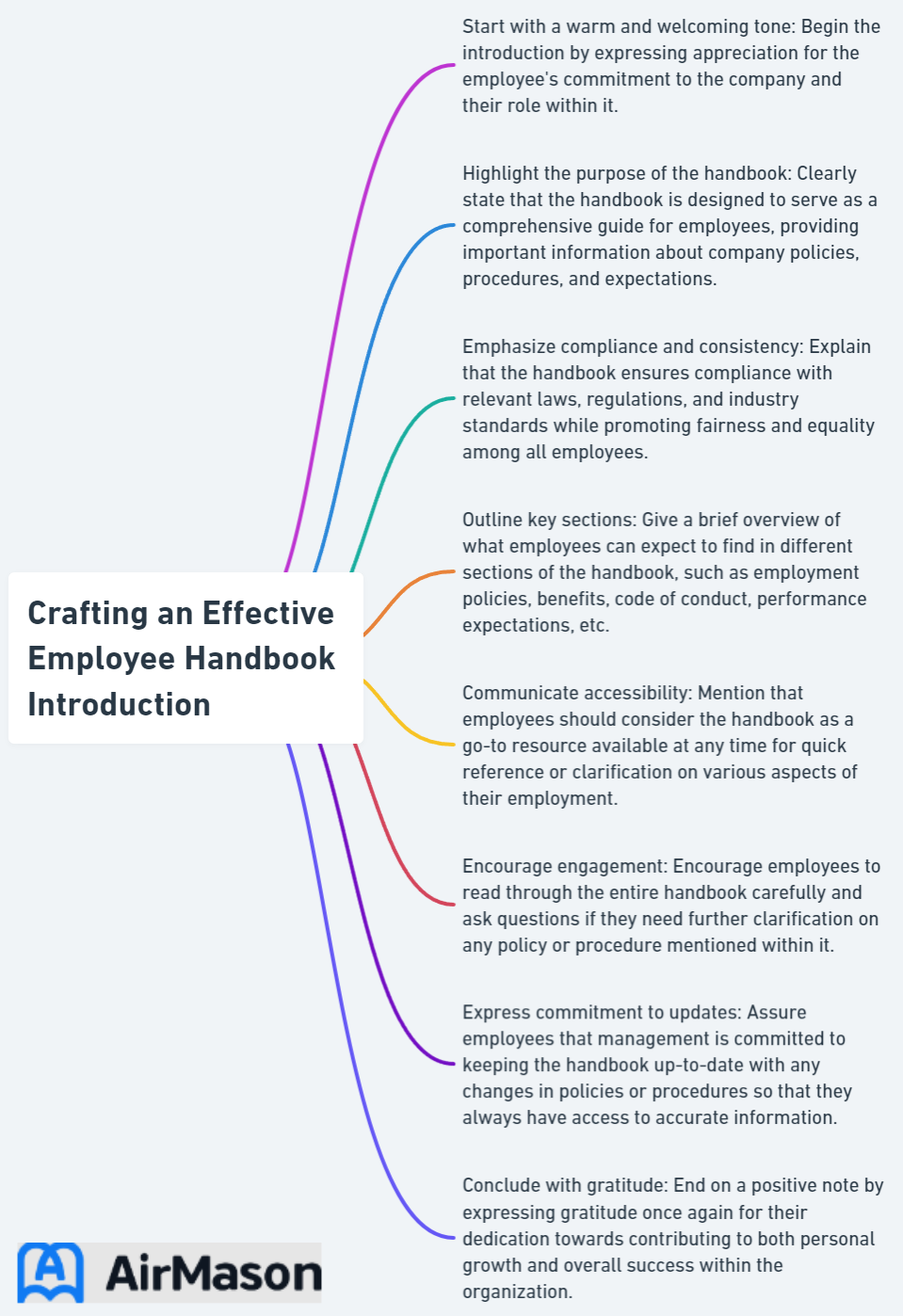
A well-crafted employee handbook introduction can set the stage for a successful and productive working relationship between a company and its employees. It’s not just about providing information; it’s about creating an engaging, relatable, and inspiring experience that reflects the organization’s personality and values. But how can you achieve this? Let’s dive into the essential elements and best practices for crafting an effective employee handbook introduction.
Key Takeaways
- An effective employee handbook introduction is essential for outlining the company’s mission, values and expectations.
- Crafting a unique introduction should include clear language, storytelling elements and maintaining a professional tone to create an inviting atmosphere for employees.
- Seeking legal advice when creating an employee handbook can help ensure compliance with relevant employment laws while staying up-to-date on changes in the law.
Create Employee Handbook
When embarking on the journey to create employee handbook, careful consideration is essential to ensure the document effectively communicates your company’s policies and values. To create an employee handbook that resonates with your team, begin by outlining clear and concise guidelines for expectations, benefits, and workplace conduct. Incorporate the “create employee handbook” process as a collaborative effort, seeking input from various departments to ensure inclusivity and relevance. It’s crucial to address key topics such as company culture, code of conduct, and HR policies, tailoring them to the specific needs and values of your organization. By strategically crafting your employee handbook, you lay the foundation for a positive work environment and foster a strong sense of unity among your staff.
The Importance of an Employee Handbook Introduction
A compelling introduction to an employee manual is foundational, underlining the company’s mission, values, and expectations. It fosters a productive, professional, and welcoming work environment, while also decreasing the amount of time needed to train employees on non-project related skills, in accordance with the company policy.
A well-written introduction that establishes an appropriate tone and context, ensures well-informed employees who resonate with the company’s goals and policies.

Key Components of an Engaging Employee Handbook Introduction
A well-crafted introduction should include a warm welcome for new employees, highlight the company’s values, and explain the purpose of the handbook. Addressing these key components lays the groundwork for a positive employee experience, aiding team members in understanding the organization’s culture, goals, and expectations from the get-go.
Welcoming New Employees
A warm and genuine welcome message in your employee handbook is indispensable to making new employees feel valued and excited to join the company. This can include:
- A personalized message from the company’s leadership or HR department
- Emphasizing the company’s culture and values
- Acknowledging new hires for their skills and contributions
- Expressing enthusiasm for their arrival
Creating an inviting atmosphere right from the start sets the stage for a successful working relationship and fosters a strong sense of belonging.
Highlighting Company Values
Showcasing your organization’s core values and mission statement in your employee handbook is vital for helping employees understand your company’s culture and goals. Clearly presenting these values offers employees a framework to guide their actions and decision-making, aligning them with the company’s vision and objectives.
Including a brief company history can also provide context for the company mission statement and give employees a sense of pride in being part of the organization’s legacy.
Purpose of the Handbook
The main goal of an employee handbook is to provide a comprehensive overview of company policies, procedures, and expectations. Clearly explaining the purpose in the handbook’s introduction is pivotal, ensuring employees understand its value as a reference and guide.
Setting clear expectations and providing a concise description of the handbook’s role assists employees in navigating company policies more effectively, contributing to a smooth onboarding process.
Crafting Your Unique Employee Handbook Introduction

Personalizing your employee handbook introduction is crucial for capturing your company’s unique identity, culture, and industry. By tailoring the content and tone to reflect your organization’s personality, you can create a more engaging and relatable experience for your employees.
Considering your company’s values, communication style, and target audience is crucial when crafting your introduction. Infusing your company’s voice and personality into the text creates a memorable and authentic experience that resonates with your team members, encouraging them to embrace the company culture and values.
Tips for Writing an Engaging and Effective Introduction

To create a compelling introduction for your employee handbook, consider using clear and concise language, incorporating storytelling elements, and maintaining consistency with your company’s tone. Following these best practices ensures an engaging, informative introduction that sets the stage for the rest of the handbook.
Use Clear and Concise Language

To make your company’s employee handbook introduction easy to comprehend, using simple, straightforward language is imperative. Avoid jargon, legalese, and overly technical terms; instead, opt for clear and concise language that reflects your company culture.
Making the information easily digestible and accessible aids employees in comprehending key policies, procedures, and expectations, paving the way for a more productive and harmonious work environment.
Incorporate Storytelling
Storytelling can be a powerful tool for crafting an engaging introduction to your employee handbook. Sharing the company’s history, mission, and vision through captivating stories establishes an emotional connection with your employees, inspiring them to contribute to the organization’s success.
Storytelling can also provide context and explain the rationale behind certain policies and procedures, helping employees better understand the company’s values and objectives.
Maintain Consistency with Company Tone
For a cohesive and authentic employee experience, aligning the introduction’s tone with your company’s overall communication style is fundamental. Using language and a tone that mirrors your company’s values and culture ensures a genuine and consistent employee handbook introduction in line with your organization’s identity.
This consistency not only helps employees better understand the company’s culture and ethos, but also fosters trust and a sense of belonging, which ultimately contributes to employee benefits.
Menards Employee Handbook
When navigating the Menards employee experience, the Menards Employee Handbook plays a pivotal role. This comprehensive guide, known as the Menards Employee Handbook, serves as a valuable resource for all Menards team members. Covering policies, procedures, and important information, the Menards Employee Handbook ensures that employees are well-informed and equipped to contribute effectively to the company’s success. Whether it’s addressing workplace protocols or providing insights into the company culture, the Menards Employee Handbook is a key reference for fostering a positive and productive work environment.
Legal Considerations for Your Employee Handbook Introduction

Consultation with legal and HR experts during the process of creating an employee handbook is essential to ensure that your employee handbook policy introduction complies with relevant employment laws and avoids potential liabilities. By familiarizing yourself with federal, state, and local employment laws, you can ensure that your handbook includes all legally required policies and procedures.
Besides working with legal and HR professionals, staying abreast with any changes in employment laws and updating your handbook accordingly is vital. This not only helps you maintain compliance but also demonstrates your commitment to maintaining a fair and legally compliant workplace for your employees. It is essential to inform employees about these updates to ensure everyone is aware of their rights and responsibilities.
Examples of Successful Employee Handbook Introductions

Learning from successful companies and their employee handbook examples can provide valuable insights and inspiration for crafting your own engaging introduction. For example, Facebook’s employee handbook (now Meta) was exceptionally crafted, resembling a luxurious coffee table book that captures the company’s innovative spirit.
Valve’s employee handbook stands out by presenting their information in a storybook format, providing a comprehensive career and company roadmap for employees, as well as an illustrated company history. GitLab’s team handbook serves as a central repository of information about the company’s operations, demonstrating their commitment to transparency and fostering a sense of trust and collaboration among employees.
Reviewing these successful employee handbook introductions and adapting their best practices to your organization paves the way for an engaging and effective introduction that resonates with your new employees employee handbooks and sets the foundation for a positive working relationship. Utilizing an employee handbook template can further streamline this process and ensure consistency across the board.
Summary
In conclusion, crafting an effective employee handbook introduction is crucial for setting the right tone, welcoming new employees, and ensuring that your team is aligned with your company’s mission, values, and expectations. By focusing on key components such as providing a warm welcome, highlighting company values, and explaining the purpose of the handbook, you can create an engaging and informative introduction. Remember to use clear and concise language, incorporate storytelling, and maintain consistency with your company’s tone to create a memorable and authentic employee experience. By following these best practices and learning from successful examples, you can set your employees up for success and foster a productive, harmonious work environment.
Frequently Asked Questions
How do you write an introduction to an employee handbook?
Welcome to our family of employees! As our most important asset, we rely on you to provide the best products, services, and customer care. This handbook will provide you with an understanding of our rules and policies that have enabled us to reach success.
How do you announce a new employee handbook?
We are pleased to announce the availability of our new employee handbook which contains key information to provide clarity, consistency, and promote engagement and productivity within the organization.
How do you describe an employee handbook?
An employee handbook is a document outlining a business’s rules, policies and expectations for their employees, as well as providing guidance and information on the company’s mission, vision and values. It serves to clarify employees’ rights and responsibilities while employed with the company, setting the tone for the employee-employer relationship.
How do you write an employee handbook policy?
Writing an employee handbook policy should include equal employment opportunity (antidiscrimination), anti-harassment, anti-retaliation, at-will nature of employment, code of conduct, general employment information, safety and security, introduction and welcome, workplace commitments, company policies and procedures, employment classification, attendance policies, leave policies, work performance, discipline policy, compensation and development, benefits and perks, working hours, PTO and vacation, and employee resignation and termination. Additionally, pay attention to format and visuals, maintain a professional tone, and consider employee appreciation in the handbook.
Why Are Employee Handbooks Important
In the realm of human resources, understanding “why are employee handbooks important” is crucial for fostering a positive and well-organized work environment. These handbooks serve as comprehensive guides, outlining company policies, procedures, and expectations, creating a unified understanding among employees. By clearly articulating the organization’s values and guidelines, employee handbooks play a pivotal role in mitigating conflicts and promoting a harmonious workplace culture. Moreover, they provide a reference point for both employers and employees, ensuring consistency in decision-making and fostering a sense of accountability. In essence, the significance of employee handbooks lies in their ability to establish a structured framework that enhances communication, compliance, and overall workplace efficiency.
What is the main purpose of an employee handbook introduction?
The main purpose of an employee handbook introduction is to set the foundation for the entire handbook, emphasizing the company’s mission, values and expectations, and welcoming new employees.